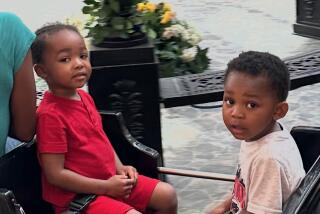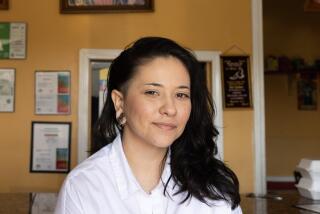Joined Twins Turn 1; Face Surgery Soon
- Share via
Conjoined twins Maria de Jesus and Maria Teresa Quiej-Alvarez turn 1 today, with a chocolate frosted birthday cake and a pinata in their UCLA hospital room.
Surgeons hope that a bigger celebration will be in order in two weeks. Separation surgery has been scheduled for Aug. 5 for the Guatemalan infants, who are joined at the top of the head and face opposite directions.
“That’s why I really have to fight for them now,” said their mother, Leticia Alba Alvarez, who came to UCLA’s Mattel Children’s Hospital with the twins in May, through a translator. “When they’re separated they’ll have a new life.”
Today, American relatives of the twins plan to take tamales to the hospital to celebrate the anniversary of their uncommon birth. With the twins’ mother and hospital staff, they will break open the pinata filled with treats and give the babies their first taste of cake.
At home in Guatemala, their grandmothers will attend a Catholic Mass celebrated in the twins’ honor today and additional Masses closer to the surgery date.
Since being flown to Los Angeles by an international medical charity, the twins have undergone numerous tests and a procedure to ensure that there will be enough skin to close the wounds after the main separation operation next month. Clear bandages now cover their foreheads and scalp.
On June 20, surgeons implanted two silicone balloons just under their shared scalp, into which they planned to inject saline to stretch the skin. During implantation, however, the skin over one of the balloons tore. Doctors did not inject saline into that balloon and removed it last week. The other remains and its stretching continues.
“We still think there’s going to be enough [skin] to cover the wound,” said Dr. Henry Kawamoto, who leads the team of craniofacial reconstructive surgeons.
Despite all that, the two Marias are babbling baby talk, blowing kisses and making new sounds.
“They are still adorable. Everybody loves them a lot,” said Dr. Jorge Lazareff, the pediatric neurosurgeon coordinating the twins’ care, who will also attend the party with other doctors and nurses.
The infants’ condition limits their movement, but the desire is there, said Jila Shiraz, a pediatric physical therapist who has worked with them since the end of June.
“Maria Teresa loves to crawl. She’s initiating crawling,” Shiraz said. “Maria de Jesus is an observer, very shy.”
The infants’ condition also restricts what they can eat, but physical therapists are teaching them to safely eat solids.
To prevent them from choking, one therapist cradles a twin in her lap while the other baby remains on a nearby bed, watched by another therapist.
Fewer than one in 500,000 live births involve conjoined babies, and those connected at the head are even rarer--fewer than one in 1 million live births, Lazareff said.
The separation surgery will take at least 10 hours, but might continue for an additional day, he said.
One of the most important steps will be separating the twins’ veins that drain into each other’s heads and letting the vascular structures of each child take the redirected blood flow, Lazareff said. Although it would not be ideal, temporary clips may be left overnight on the vessels to allow the other drainage systems to compensate.
Four pediatric anesthesiologists will work on shifts throughout the separation, as will two teams of plastic surgeons and two teams of neurosurgeons.
Neurosurgeons at UCLA have never separated conjoined twins, but they have worked on more complicated procedures before. The real challenge, Lazareff said, is operating on two babies at the same time.
Any anesthesia will pass through their shared bloodstream, Lazareff said. And their physical condition complicates their position on the operating table.
“It’s a geometry problem for us because these kids are not stuck together symmetrically,” Kawamoto said.
Doctors are not sure how much time the girls will need to recover.
UCLA enlisted the help of Biomedical Modeling Inc., a Boston-area company, to create replicas of the twins’ skulls, based on CT scans. The company donated the models, valued at about $10,000.
The physicians have made discoveries from the plastic models. Kawamoto noticed that the infants’ heads and faces are flattened on their left sides and their ears are not aligned.
“One would expect some self-correction after the twins are freed from the prison of their position. However, complete normalization is not expected,” he said.
Major surgery would be needed to fully alleviate the flattening, but Kawamoto does not recommend that, since the deformity will not inhibit jaw movement or further development.
Born in a Guatemalan village, the two Marias spent most of their first nine months in a pediatric intensive care unit of a government hospital, far from their parents.
An international charity, Healing the Children, connected Lazareff with the babies and arranged for their travel to the United States in May. All the physicians involved are donating their services.
UCLA Medical Center has received more than $4,000 in donations to help pay for the twins’ care, but hopes for a lot more to offset costs estimated to exceed $1.5 million.
More to Read
Sign up for Essential California
The most important California stories and recommendations in your inbox every morning.
You may occasionally receive promotional content from the Los Angeles Times.













